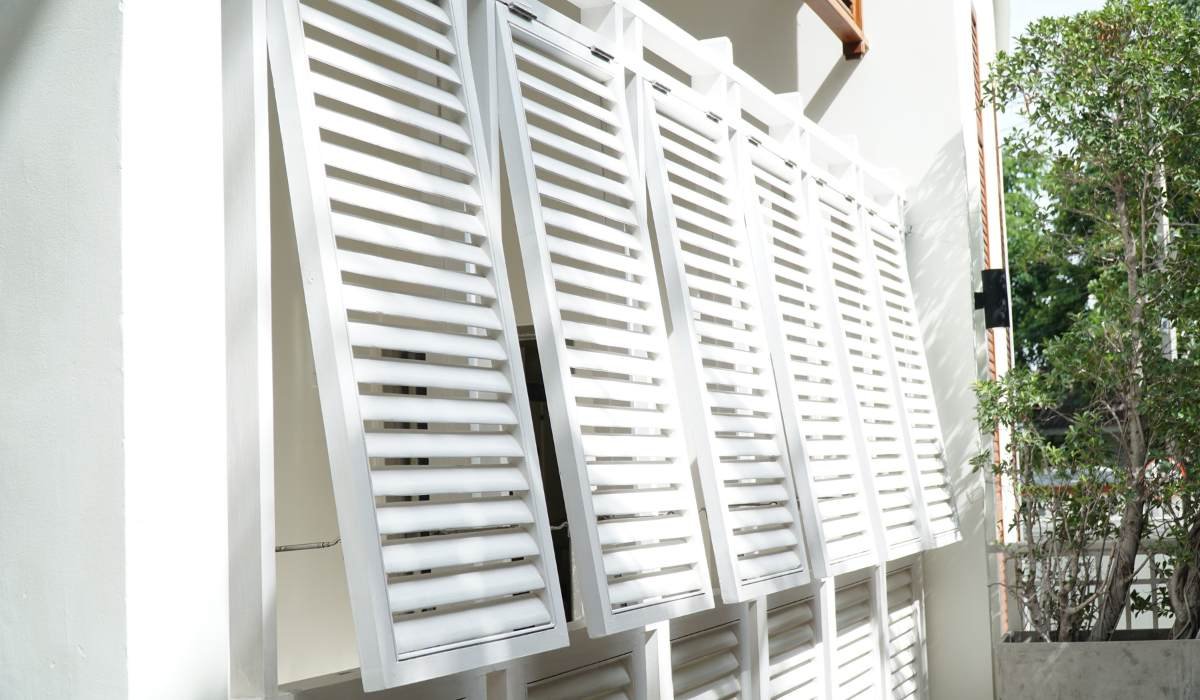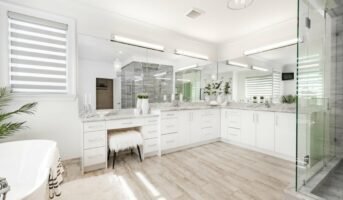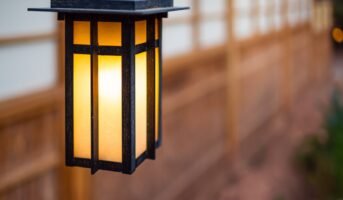In the dynamic and ever-evolving world of architecture and interior design, both Louvre shutters and Louvre windows have carved out a niche for themselves as sought-after choices. But one might wonder, what exactly are the key differences between these two? How do they function in various design contexts and what factors should you keep in mind when choosing between them? In this article, we aim to answer all these questions and provide a comprehensive comparison.
See also: Types of windows
Key differences
At a glance, both Louvre shutters and Louvre windows feature a series of horizontal slats that are visually striking. However, their functions and applications differ considerably, adding to the diversity of their usage.
Louvre shutters are primarily designed to control light and provide privacy. They can be installed on either the interior or exterior of your windows, offering flexibility in terms of design and utility. The adjustable slats can be tilted to regulate the light entering the room, making them a practical solution for light-sensitive spaces like bedrooms or study rooms.
In contrast, Louvre windows are a unique type of window themselves. They perform exceptionally well in ensuring ventilation while keeping out rain, making them ideal for climates with frequent rainfall. Their slats can be controlled to adjust the airflow, thus helping maintain a comfortable temperature indoors.
Design ideas
Louvre Shutters
Classic plantation style
With their wide slats, plantation Louvre shutters offer a timeless look that suits a wide variety of home styles. They are reminiscent of traditional Southern architecture and bring a touch of elegance to any room.
Cafe style
These shutters cover only the lower half of your window, offering a chic, European touch. They are perfect for kitchens and dining areas where you want a blend of natural light and privacy.
Tier-on-tier
This flexible design allows the top and bottom halves to operate independently, providing versatile light and privacy control.
Solid Louvre shutters
For those seeking an old-world charm, solid Louvre shutters that provide complete blackout are an excellent choice. They are perfect for bedrooms and media rooms where total light blockage is required.
Tracked Louvre shutters
Ideal for large windows or doors, these shutters slide on a track. They are a great solution for patio doors or wide windows where a single shutter panel would be too large.
Louvre windows
Bathroom sanctuary
Louvre windows in the bathroom provide privacy while swiftly letting out steam, creating a comfortable and clear atmosphere.
Kitchen servery windows
Louvre windows can turn your kitchen into a functional servery. They make passing food and drinks to your outdoor area a breeze, perfect for those who love to entertain.
Stairwell light
Installing Louvre windows in hard-to-reach places like stairwells can let in natural light, making the area feel more spacious and welcoming.
Indoor-outdoor flow
Floor-to-ceiling Louvre windows can seamlessly connect your interior and exterior spaces, enhancing the sense of space in your home.
Eco-friendly design
Pair Louvre windows with other window types for a sustainable design with great airflow. The adjustable slats allow for natural temperature control, reducing reliance on air conditioning.
Important considerations
When choosing between Louvre shutters and windows, there are several factors to take into consideration:
Ventilation needs
Louvre windows are excellent for ensuring ventilation while keeping out rain, making them ideal for climates with frequent rainfall.
Light control
Louvre shutters are designed to control light, making them a practical solution for light-sensitive spaces.
Privacy needs
Louvre shutters can provide effective privacy when installed on either the interior or exterior of your windows.
Local climate
The local weather conditions can influence your choice. For instance, Louvre windows are suitable for areas with frequent rainfall.
Room requirements
The specific needs of the room where they’ll be installed should also be taken into account.
Maintenance requirements
Both shutters and windows require regular maintenance to maintain their appearance and functionality.
Maintenance tips
Regular upkeep is crucial for both Louvre shutters and windows to maintain their appearance and functionality:
Regular cleaning
Cleaning with a soft cloth can help to keep your Louvre shutters and windows looking their best.
Avoid harsh chemicals
Harsh cleaning chemicals can damage the materials of your shutters and windows, so it’s advisable to avoid using them.
Professional help
For any mechanical issues or complex maintenance tasks, it’s recommended to contact a professional to prevent further damage.
Regular inspections
Regular inspections can help detect any potential issues early, preventing large-scale damage and costly repairs.
Lubrication
The moving parts of Louvre shutters and windows should be lubricated regularly to ensure smooth operation.
Replacement of damaged parts
Any damaged parts should be replaced promptly to prevent further damage and ensure optimal functionality.
Both Louvre shutters and windows come with their unique set of benefits and considerations. They cater to different needs and aesthetics and the choice between the two should be carefully determined by the specific requirements of your space. Hopefully, this comprehensive article has provided you with valuable insights to make an informed decision for your next design project.
FAQs
Louvre shutters are primarily designed to control light and provide privacy. They can be installed on either the interior or exterior of your windows.
Louvre windows perform exceptionally well in ensuring ventilation while keeping out rain, making them ideal for climates with frequent rainfall.
Some ideas include classic plantation style, cafe style, tier-on-tier design, solid Louvre shutters and tracked Louvre shutters.
Some ideas include Louvre windows in the bathroom for privacy, kitchen servery windows, stairwell light, indoor-outdoor flow and eco-friendly design.
Consider your need for ventilation, light control and privacy. The local climate should also play a significant role in your decision-making process.
Regular cleaning with a soft cloth is crucial for both shutters and windows. Refrain from using abrasive chemicals that could potentially harm the materials. For any mechanical issues or complex maintenance tasks, it's recommended to contact a professional.
Both Louvre shutters and windows can be used in a variety of rooms, but the specific requirements of the room where they'll be installed should be considered. What are the main uses of Louvre shutters?
What are the advantages of Louvre windows?
What are some design ideas for Louvre shutters?
What are some design ideas for Louvre windows?
What factors should I consider when choosing between Louvre shutters and windows?
How should I maintain my Louvre shutters or windows?
Are Louvre shutters and windows suitable for all types of rooms?
| Got any questions or point of view on our article? We would love to hear from you. Write to our Editor-in-Chief Jhumur Ghosh at [email protected] |

Upasana Mandhata, currently in her final year of Law, is pursuing a BA LLB Degree at VIT University Chennai. Her interest in content creation dates back to her school and college years when she discovered a writing passion. Drawing from personal experiences, her writing style has been shaped by her journey and encounters. She enjoys experimenting with new recipes, painting, or swimming while clocking out of work time.











